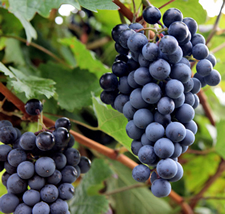Untitled Document

|
| |
Spätburgunder
|

Photo: © Bilderjet - Fotolia.com |
Also known as: Pinot Noir, Klevner, Pinot Nero, Blauburgunder
What the Riesling means to German white wines is what the Spätburgunder means to Germany's red wines. It is the most important red grape in the Baden, Ahr, and Rheingau regions, and there are significant plantings in the Pfalz, Rheinhessen, and Württemberg regions. In total, 29,175 acres (11,807 hectares) or 11.6% of the German wine regions are covered with Spätburgunder vines.
The Spätburgunder belongs to the Burgundy family of grapes. This grape belongs to oldest varieties, originating from wild vines in Middle Europe. The grape was first introduced into Germany in 884 AD, and in the 1200's it was first planted in the Rheingau region. By the 1500's it was found throughout the Pfalz region, and in the 1700's it was planted in the Ahr region.
Spätburgunder grapes are used mainly for red wine production, however a small portion is used in rosé wines and sparkling wines. If the grapes are pressed immediately after harvesting, they release a light juice, which is made into Blanc de Noir wine - a white wine made from red grapes.
Spätburgunder red wines are light to medium red in color. They are full bodied, smooth, and their sweet aroma shows hints of strawberries, cherries, boysenberries, and almonds. These wines are great for the colder months. They pair well with rich, hearty dishes, such as roasts, game, and cheese platters. The Spätburgunder rosé wine goes well with light meals and appetizers.
|
|
|

